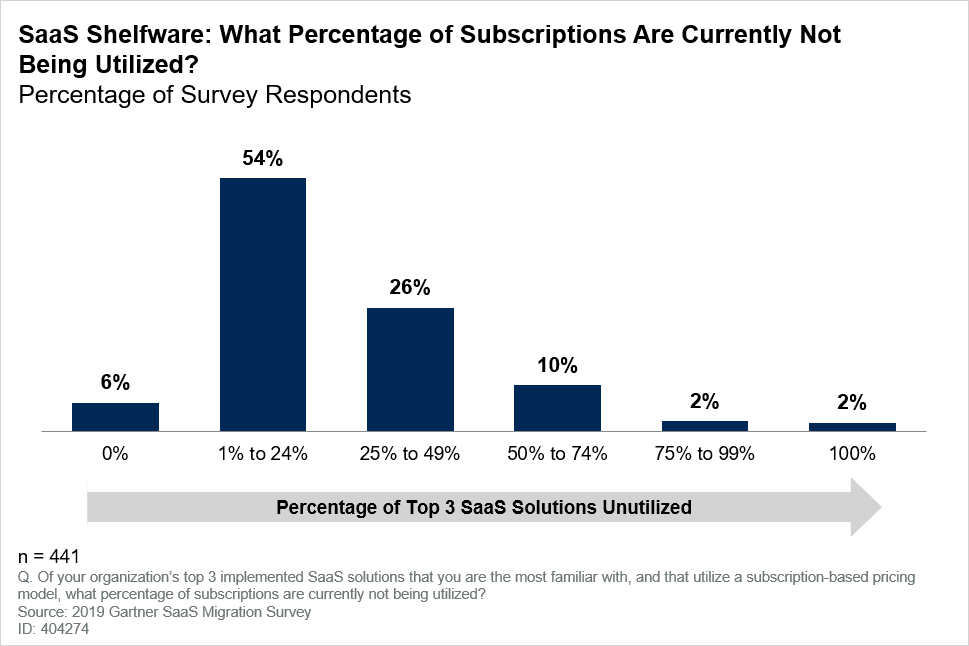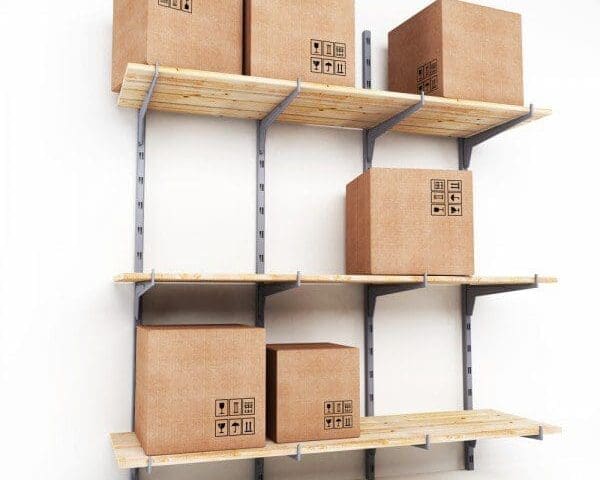Get the most from your software investments
What is Shelfware?
Shelfware is a slang term used to describe a piece of software that is rarely or never used. Many believe in the inevitability that some software in the organization will be underused, but if addressed proactively, your company can save money by avoiding it entirely. According to a 2019 Gartner SaaD Migration Survey, typical IT operations do not use 25% of the software they purchase. A separate study by Flexera Software found that 93% of organizations have some shelfware, while more than a third waste at least 21% of their software spending on neglected software. Controlling IT cost is no longer on the radar of CIOs, whose priority has shifted to create business value in many other ways.

Source: 2019 Gartner Saas Migration Survey
Why you should act now to eliminate unnecessary software spend
The Software industry has developed a nasty reputation for overselling. Think about how many licenses you have right now and how many you actually use. Now multiply that by everyone in the organization. The problem is global and is why the term “shelfware” was coined. Avoiding shelfware, is as simple as only buying what you need.
The process of finding the right software for your needs requires stakeholder buy-in. For the most part, making sure that everyone gets what they need out of the decision-making process is complicated. The process is lengthy and often avoided, resulting in expensive, unnecessary software being purchased and unused.
Technology upgrades will doom lots of under-utilized software to become unnecessary or redundant in the race to move operations and collaboration online. Without Software Asset Management (SAM) discipline, it is not easy to manage unnecessary SaaS costs, especially if your contract is not up for renewal for a while.
“To put into context how prevalent the “shelfware” problem has become, Gartner predicts that by 2022, the global information security spending will exceed USD 170 billion. Additional research shows that nearly 30% of all security investments are underutilized or never implemented. That’s over $51 billion. Most of that spend is driven by financial institutions and Fortune 500 companies.”
Every organization has shelfware, which generally refers to software purchased but never used. However, not everyone realizes that this unused software could pose potential quality or security risks, which in turn impact both customer satisfaction and brand reputation, and ultimately could be bleeding your digital transformation budget dry. You can avoid wasting money on shelfware by taking action now and managing your tech stack objectively and diligently.
We’ve put together a few steps to help you stop buying shelfware.
5 steps to prevent and avoid shelfware
1. Find the right software for your organization every time you buy
It may seem obvious, but the truth is that most shelfware results from the wrong purchase decision being made by the organization. It’s important to perform a thorough technology evaluation process to ensure that you are matching solutions directly to the needs of the business and not choosing something based only on reviews.
2. Before you buy, deeply understand the needs of the organization
It is important that when you go through the software selection process, you deeply understand the functional and non-functional requirements from the perspective of the entire business so that you can make the right choice. Take the functional and non-functional requirements and ask these stakeholders to rank them, so you know exactly what criteria should dictate the choice. Evaluate the solutions available based on these requirements.
3. Perform thorough technology evaluations on all software purchases
Taking the time to properly evaluate all the software solutions on the market and evaluate the options based on the company needs is crucial to ensuring that no purchase sits on the shelf. Perform a thorough technology evaluation process to ensure that you are matching solutions directly to the needs of the business and not choosing something based only on reviews.
4. Include key stakeholders in your technology evaluation and software selection process
To find the right solution, it is necessary to ask your stakeholders what they need. Asking key stakeholders in the business to gather their requirements will ensure that their needs are captured and addressed. Ranking these requirements in collaboration with key stakeholders will ensure consensus on the business’ needs. Including reps from all departments will positively contribute to high user adoption later because they will feel heard, and the software chosen will meet their needs. This stage also helps you catch any issues that may prevent the software from becoming shelfware (low user adoption), such as key integration required for the solution to work for the entire business.
5. Discover the right solutions that the organization will highly adopt
Before going to vendors, get clear on the evaluation criteria that dictate the choice. Companies use software like Olive to collaborate on gathering and ranking requirements and match solutions to them. If you decide to do this manually in spreadsheets, be advised that it will take a long time. Ensure that the solutions you decide to shortlist and demo match these needs. Failing to do this, going straight to a few solutions, and trying to shoehorn them into your needs fails and results in the solution becoming shelfware.
“At the end of the day, shelfware is software the company doesn’t use, so putting the business needs at the center of the decision and doing anything you can to engage stakeholders in the decision-making process increases the chance of the company using it.”
Shelfware eats away at your digital transformation budget and hides a potentially more serious issue; that you are not solving your organization’s challenges accurately
By following these basic methodologies, you can overcome many of these challenges to deliver value to your teams and ensure adoption. It all starts with engaging your stakeholders and thoroughly evaluating all potential options. With Olive, managing your tech stack and ensuring that you are not paying for products you don’t need is accessible at a glance. You can easily see a list of vendors, an overview of how they meet your business needs, and how critical each requirement is to various stakeholders. Stop wasting up to 25% of your software budget on shelfware. Increase user adoption, discover better solutions and get ROI on your purchases with Olive.
Request a demo
Acknowledgments
Part of the information in this article comes from:
Stephen White: Paying for what you use – too much to expect from SaaS? by Gartner January 2020
Flexera Releases 2020 State of the Cloud Report





